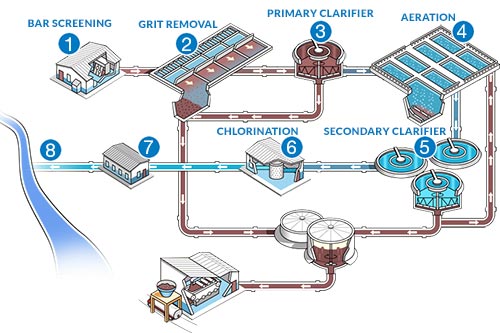Improving Wastewater Treatment with Green Innovations
Improving Wastewater Treatment with Green Innovations
Blog Article
Understanding Wastewater Treatment Processes and Their Environmental Effect
The intricacies of wastewater therapy procedures play an essential function in mitigating ecological obstacles connected with water contamination. Each phase, from preliminary to innovative treatments, is developed to resolve certain contaminants, inevitably securing both public wellness and water ecosystems.
Summary of Wastewater Therapy
Just how is wastewater changed right into a risk-free source for the setting? Wastewater therapy is a critical process developed to remove pollutants from utilized water, thereby protecting public health and protecting communities. This procedure starts with the collection of wastewater from household, industrial, and business resources, which is then routed to treatment centers.
At these facilities, different physical, chemical, and biological methods are used to deal with the wastewater. First testing eliminates huge particles, complied with by sedimentation to different heavier solids. Consequently, organic treatments, such as turned on sludge processes, use microbes to damage down raw material. These approaches not just minimize toxin levels however additionally facilitate the healing of useful nutrients.
The dealt with effluent can be securely released right into natural water bodies or reused for irrigation and industrial purposes, promoting resource conservation. In addition, the therapy procedure creates biosolids, which can be repurposed as plant foods or soil changes, better enhancing sustainability.
Phases of Treatment Processes
The wastewater treatment process typically contains 3 primary phases: preliminary, primary, and second treatment. Each stage serves a distinct function in reducing the contaminant tons and guaranteeing the effluent satisfies environmental requirements prior to discharge.

The main therapy stage focuses on the physical separation of put on hold solids from the wastewater. Via sedimentation, much heavier bits settle at the bottom of sedimentation tanks, forming sludge, while lighter materials, such as oils and oils, float to the surface area and are skimmed. This process dramatically reduces the organic and not natural lots in the wastewater.
Second treatment is a biological procedure intended at additional lowering the concentration of organic issue. This phase is important for attaining the needed biochemical oxygen demand (FIGURE) decrease, eventually leading to cleaner effluent all set for discharge or further therapy.

Advanced Treatment Technologies
Following the secondary therapy procedures, progressed treatment technologies play a crucial duty in additional enhancing the quality of treated wastewater. These modern technologies are developed to remove residual pollutants that are not successfully eliminated throughout main and additional therapies, making sure the effluent fulfills stringent regulative requirements.
Among the commonly made use of advanced treatment methods are membrane layer purification, reverse osmosis, and advanced oxidation processes. Membrane filtering, consisting of microfiltration and ultrafiltration, is efficient in separating fine fragments, microorganisms, and colloids from the water (Wastewater). Reverse osmosis uses semi-permeable membranes to get rid of liquified solids, causing high-quality water ideal for different applications
Advanced oxidation procedures (AOPs) utilize strong oxidants to weaken organic contaminants, consisting of pharmaceuticals and individual treatment items that are immune to standard therapy. These methods improve the biodegradability more of complex compounds, facilitating their elimination.
Another substantial technology is the use of organic nutrient removal processes, which especially target nitrogen and phosphorus, preventing eutrophication in getting water bodies. On the whole, innovative therapy modern technologies are important for attaining higher degrees of purification, advertising water reuse, and guarding public health and wellness while attending to the challenges linked with wastewater management.
Ecological Advantages of Treatment
Various environmental benefits occur from efficient wastewater treatment processes that add to ecosystem health and sustainability. Mainly, these procedures significantly reduce the release of harmful pollutants into all-natural water bodies, which assists keep aquatic environments. By removing impurities such as hefty metals, nutrients, and virus, treated wastewater minimizes the threat of waterborne illness and advertises biodiversity in marine atmospheres.
In addition, wastewater treatment facilities frequently utilize innovative innovations that make it possible for water recycling and reuse. This method not just saves fresh water resources yet additionally decreases the need on all-natural water supplies. Enhanced nutrient elimination from wastewater can likewise avoid eutrophication, a process that results in algal flowers and subsequent oxygen exhaustion in marine systems.
Additionally, effective therapy processes can decrease greenhouse gas discharges, especially methane and nitrous oxide, which are often launched during untreated wastewater decay. By capturing and utilizing biogas from anaerobic digesters, facilities can convert waste right into eco-friendly power, thus adding to a decrease in nonrenewable fuel source dependence.
Obstacles and Future Patterns
While the environmental benefits of wastewater therapy are clear, a number of difficulties continue that hinder optimum end results in this area. One significant concern is maturing infrastructure, which usually leads to ineffectiveness and enhanced functional expenses - Wastewater. Many therapy plants were created years back, and their abilities do not align with modern demands, that include stricter regulatory criteria and greater volumes of wastewater due to urbanization

Looking ahead, there is a growing emphasis on source healing and circular economic climate concepts within wastewater treatment. Technologies such as anaerobic digestion, which can create biogas, and progressed filtration technologies are obtaining traction. These methods not only improve therapy performance yet additionally promote sustainability.
Inevitably, addressing these obstacles calls for cooperation among stakeholders, investment in technology, basics and a dedication to recurring research study. By welcoming these fads, the wastewater therapy sector can progress to satisfy the demands of a changing environment and society.
Conclusion
To conclude, wastewater treatment procedures play an essential function in enhancing environmental high quality and public wellness. The multi-stage treatment framework, paired with innovative modern technologies, effectively alleviates air pollution and advertises lasting water administration. By attending to residual impurities and decreasing nutrient webpage drainage, these procedures add to the conservation of marine communities and the decrease of greenhouse gas discharges. Proceeded improvements and adjustments in treatment methods will be necessary for getting rid of arising obstacles and ensuring the sustainability of natural resources (Wastewater).
Report this page